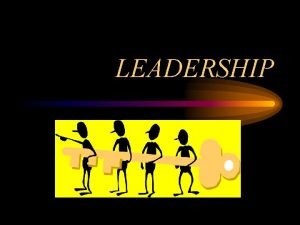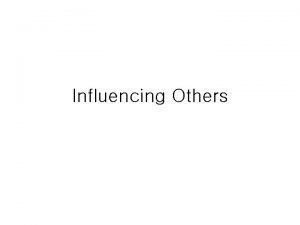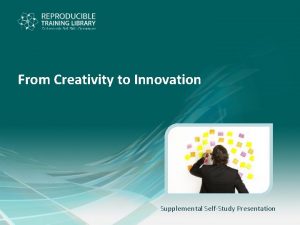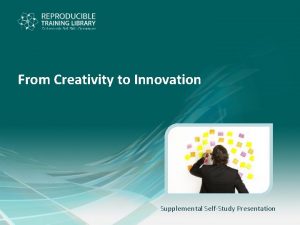The Art of Influencing Others Supplemental SelfStudy Presentation










































































- Slides: 74

The Art of Influencing Others Supplemental Self-Study Presentation

The Art of Influencing Others Overview

The Art of Influencing Others Introduction Upon completion of this course, you’ll be able to: • Identify the principles of influence and persuasion. • List skills needed to build rapport and develop genuine relationships. • Recognize differences in communication styles. • Identify ways to tailor your communication style to increase your influence with others. Getting Ready to Learn Think about the following questions: • What is influence? What is persuasion? • How are they different from manipulation? • How do you know when you’ve influenced someone? • Can you measure it? This program will help you answer these questions by helping you understand the nature of influence and persuasion, and giving you tools to be more successful at it.

The Art of Influencing Others Definition of Influencing This program is based on the philosophy of achieving results without manipulation. Influence and persuasion are NOT manipulation, bribing, or forcing people to your point of view. Our definition of influence: • The ability to win others to your way of thinking Other definitions: • The ability to change people’s minds without resentment • The ability to affect the outcome of something through gentle actions

The Art of Influencing Others Direct Influence A lot of the time, influencing is a necessary part of daily business activities/functions. Examples of direct influence include: • Negotiations • Proposals • Meetings • Sales conversations • Debates and discussions • Performance management

The Art of Influencing Others Indirect Influence can also operate in a less open and direct manner. Even though you are not necessarily trying to influence a person at a particular moment, you can still have an effect by: • Sending a message through the combination of your words and behaviors • Serving as a role model or mentor • Altering an attitude, image, or behavior • Building a network of nurturing relationships

The Art of Influencing Others How Does it Happen? Use all of the following strategies to increase your ability to influence and persuade others: • Build rapport. • Eliminate obstacles or barriers to communicating. • Recognize different communication styles and tailor your style to match the other person’s— in other words, speak their “language. ” • Follow the “recipe” for success: likeability, reciprocity, credibility, and commitment. We will look at each of these “ingredients” in the recipe for success in detail later in this course.

The Art of Influencing Others Test Your Knowledge Read the scenario and decide if it’s an example of INFLUENCING or MANIPULATION. Scenario: Your boss is looking for volunteers to staff your organization’s booth at a local recruiting fair. The work shift is on a Friday evening, and so far no one has volunteered. Your boss tells your department that anyone who volunteers will get a day off the following week. This is an example of: A. Influencing B. Manipulation

The Art of Influencing Others Test Your Knowledge Read the scenario and decide if it’s an example of INFLUENCING or MANIPULATION. Scenario: Your boss is looking for volunteers to staff your organization’s booth at a local recruiting fair. The work shift is on a Friday evening, and so far no one has volunteered. Your boss tells your department that she will be working at the booth herself, and emphasizes the benefits of meeting people from other parts of the organization at the event. This is an example of: A. Influencing B. Manipulation

The Art of Influencing Others Module 1: Building Rapport

The Art of Influencing Others Establish Common Ground One of the keys to influencing others is to build rapport. And the first step in building rapport is to establish common ground. The things we have in common with other people form the basis for connecting. • Work to find similarities. • No matter how diverse a work group is, there always areas of common ground. Obvious similarities are the elements of work itself—projects, goals, deadlines, etc. • Next, get to know your coworkers as individuals—find out about their interests, families, etc. • Create an atmosphere of inclusion, that is, welcoming and supporting others. Ask new people to lunch, talk about subjects other than work, etc.

The Art of Influencing Others Listen Actively Listening actively is the foundation for finding common ground, building rapport and influencing others. Effective listening begins before the conversation. Prepare mentally: • o Review what you know about the subject. o Suspend any preconceived judgments, prejudices, and emotions you have about the speaker or the subject. Focus on the speaker: • o Let the other person go first, and keep going until they feel heard. o Avoid distractions by closing your door if you have one, sitting close to the speaker, and turning off your phone. o Show your interest with your words and body language. Close the conversation appropriately: • o Summarize key points to confirm understanding, propose future actions, and express appreciation to the speaker for sharing.

The Art of Influencing Others Mirroring to Build Rapport Building rapport can be enhanced by “mirroring” how a person talks, how he or she uses their body, and even how they breathe. To sum up, you can mirror someone’s: • Tone of voice • Rate of speech • Body posture • Breathing Note: Mirroring is not imitating or mimicking. It is subtly reflecting the other person’s energy and frame of mind.

The Art of Influencing Others Test Your Knowledge Can you match each gesture with the message it sends in typical American culture? Click to the next slide to see the answers. Rubbing back of head ? Defensiveness Raising eyebrows ? Frustration Stroking chin ? Thinking/interest Crossed arms ? Self-confidence Steepling fingers ? Surprise

The Art of Influencing Others Test Your Knowledge Part 2 Rubbing back of head = Frustration Raising eyebrows = Surprise Stroking chin = Thinking/interest Crossed arms = Defensiveness Steepling fingers = Self-confidence

The Art of Influencing Others Neuro-Linguistic Programming Another way to build rapport is using neuro-linguistic programming, or NLP. It is based on the idea that most people have a preferred channel of communication, visual, auditory, or kinesthetic. If you can recognize another’s preferred channel and consciously choose words that reflect that person’s preference, you will be able to build rapport and influence that person more easily. Visual: People who prefer the visual channel like to look at, see, or read things. They use words such as, “I see what you mean, ” or “Put it in writing. ” Auditory: People who prefer the auditory channel like to hear, discuss, and explain things. They say things such as, “I hear what you’re saying, ” or “Let’s discuss this further. ” Kinesthetic: People who prefer the kinesthetic channel like to touch or do things. They use words such as, “I sense this is important to you, ” or “We’ll handle it your way. ”

The Art of Influencing Others Test Your Knowledge Identify the channel (visual, auditory, or kinesthetic) indicated by the following word choices. Click each item to see the answer. “Roll with the punches. ” 1. 1. Kinesthetic 6. “Do grasp my idea? ” 6. you Kinesthetic “I hear what you’re saying. ” 2. 2. Auditory 7. “We’ll handle it your way. ” 7. Kinesthetic “I see what you mean. ” 3. 3. Visual 8. “Let’s discuss this further. ” 8. Auditory 4. 4. Kinesthetic “Let me show you what I mean. ” 9. Auditory 9. “Sounds good to me. ” “Hmmm, let’s see. ” 5. 5. Visual 10. “Put it in writing. ” 10. Visual

The Art of Influencing Others Use Self-Disclosure Another tool for building rapport is self-disclosure. Self-disclosure: • Enables you to build a deeper connection with another person by revealing your own thoughts and feelings • Is not simply providing information to another person. Instead, it is sharing information with others that they would not normally know or discover • Involves risk and vulnerability on the part of the person sharing the information • Creates an opportunity for him or her to open up to you.

The Art of Influencing Others Skills to Improve Understanding Throughout this course we are emphasizing the importance of understanding others as a foundation to influencing without manipulation. Understanding can deepen both as a listener and speaker. As the Listener: As the Speaker: Listen to understand the other person’s point of view. Share your assumptions, perceptions, and conclusions. Acknowledge the other person’s thoughts and feelings. Clearly state your own reasoning. Ask questions to clarify. Ask the other person to consider your views. Reflect on the other person’s comments. Build on the other person’s comments.

The Art of Influencing Others Paraphrasing Statements Paraphrasing what the other person has said builds rapport by demonstrating you have really heard him or her and care about what they have to say. • Paraphrasing statements reflect the content, the actual words spoken, as well as the feelings of what a speaker has said. • The purpose of paraphrasing is to confirm what has been expressed rather than move the conversation along. • In order to paraphrase effectively, you must listen for intentions, needs, and feelings. Speaker: “I refuse to work with someone who is such a drag on the team. ” Listener: “It sounds like you’re frustrated that this person isn’t contributing. ”

The Art of Influencing Others Communication Filters, by definition, separate. Communication filters affect how we think about our communication with others, and how we interpret what others say to us. Common filters include age, culture, ethnicity, and gender. For example, age is a communication filter. The era in which a person grew up creates in that person a perspective he or she considers “normal. ” The underlying assumption accompanying that perspective is that other perspectives are “not normal. ” Additionally, as people age, the accumulation of life experiences continually teaches them and affects their perspective about themselves and their world. Therefore, you must be careful to uncover filters that may lead to inaccurate assumptions about others.

The Art of Influencing Others Assumptions: Communication Behaviors Another filter that affects our communication is what we assume about certain communication behaviors. We tend to think our way is the “right” way and any other way is wrong, rude, or strange. Then we make judgments or jump to conclusions about someone based on their communication behaviors, and not based on any “real” evidence. Style Differences to Consider • Animation/energy • Directness of questions and answers • Gestures • Touching • Closeness when standing • Punctuality As you review these style differences, keep in mind that some behaviors are personal, while others are cultural. You need to avoid making judgments about a certain group of people based on your experience with one person from that group.

The Art of Influencing Others Reframe Difficult Situations When you have experienced a “disconnect” with another person, it’s important to reframe the situation to focus on positive intentions and productive outcomes. How to Overcome a “Disconnect” • Take a step back and focus on what’s important and productive. • Recognize your “hot buttons” and develop appropriate responses that will help you maintain your composure. Emotions can quickly escalate when you are feeling frustrated and not on the same page with the other person. Avoid the temptation to react to your hot button. • Try to determine the other person’s true reasons for what he/she has said or done. Look for a need that is being met by the person’s words or actions.

The Art of Influencing Others Test Your Knowledge Read the scenario and then click on the action you believe is LEAST likely to have a positive effect on building rapport. Scenario: You are getting acquainted with a new colleague who you believe could be a strong ally in your plan to revamp the system for handling customer complaints. Yet, you are having a difficult time connecting with him. A. The next time you meet, look for clues about whether he prefers a visual, auditory or kinesthetic approach to communication. B. The next time you meet, talk about yourself and share some meaningful or significant information about yourself. B. The next time you meet, consider what filters such as age, culture or ethnicity may be creating negative assumptions. B. The next time you meet, mimic his nonverbal gestures exactly.

The Art of Influencing Others Module 2: Recognizing Communication Styles

The Art of Influencing Others Communication Styles People communicate differently—some prefer to focus on relationships and feelings, others on tasks and facts. Some use a direct approach, while others are more comfortable using an indirect approach. These basic differences combine to form different communication styles. People respond more positively to their preferred style. If you recognize another person’s style, you can tailor your message to speak their ”language. ” That will increase your rapport and build a stronger connection, which increases your ability to influence them. On the next slide, you will have an opportunity to determine your preferred style. Focus on relationships Indirect Connecting Creating Computing Commanding Focus on tasks Direct

The Art of Influencing Others Explanation of the Four Basic Styles Anyone can fall into any quadrant at any time because this analysis is based on observable behaviors. In fact, it’s useful to use the phrase, “What mode are they in? ” when trying to identify someone’s style. Remember, the goal is recognize someone’s preferred style so you can adjust your approach to meet their preference. Focus on relationships Indirect Connecting Creating Prefers indirect approach with a focus on people Prefers direct approach with a focus on people Computing Commanding Prefers indirect approach with a focus on tasks Prefers direct approach with a focus on tasks Focus on tasks “What mode are they in? ” Direct

The Art of Influencing Others “Creating” Style Communicators Each communication style exhibits certain strengths and shortcomings. This chart lists many typical behaviors of people who have a preference for a direct, people-driven approach. Use these cues to help you recognize a Creating communicator. Strengths Shortcomings High energy, exciting, or fastmoving Easily bored, disorganized Receptive to new ideas Poor attention to details Likes to be involved with others Impatient with slow movers and thinkers Aware of others’ feelings Daydreams and “checks out” Spontaneous Bounces from activity to activity Can make decisions rapidly Weak on follow-through

The Art of Influencing Others Messages: “Creating” Communicators Here are seven ways to tailor your message to a Creating communicator: • Be creative and enthusiastic. • Don’t waste time with facts. • Explore all possibilities. • Avoid long explanations. • Strive for uniqueness. • Encourage using intuition. • Constantly brainstorm and create.

The Art of Influencing Others “Commanding” Communicators This chart lists cues to help you recognize a Commanding communicator These are people who have a preference for a direct, task-driven approach. Strengths Shortcomings Ambitious and self-confident Inadvertently inconsiderate Natural leader, takes charge Has difficulty being a “follower” Responds well to challenges Likes to have their own way Goal-oriented Dislikes long-term projects Driven Not a great listener Active and independent Lacks patience with others

The Art of Influencing Others Messages: “Commanding” Communicators These ideas will help you tailor your message to Commanding communicators: • Let them be in charge. • Have order and logic in your presentation. • Get to the point as quickly as possible. • Stand your ground confidently. • Give only a few details. • Show benefits to them personally. • Don’t promise what you can’t deliver.

The Art of Influencing Others “Computing” Communicators The chart lists traits and behaviors that characterize Computing communicators who prefer an indirect, task-driven approach. The chart lists traits and behaviors that characterize Computing communicators. Strengths Shortcomings Good problem solver Hates to be wrong Steady and deliberate Needs to have all the facts Intelligent and knowledgeable Hesitant to make decisions Not distracted by emotion Little tolerance for ambiguity Methodical, orderly, and systematic Inflexible, resistant to change Takes responsibility seriously Unwilling to “guesstimate” and uncomfortable offering opinions

The Art of Influencing Others Messages: “Computing” Communicators Here are seven ways to tailor your message to Computing communicators: • Be organized and prepared. • Provide lots of data and information. • Explain systematically. • Analyze all the facts. • Focus on ideas, not people. • Give lots of time to decide. • Have written support for your plan or idea.

The Art of Influencing Others “Connecting” Communicators This chart describes typical behaviors of Connecting communicators who prefer an indirect approach and a strong focus on people and relationships. This chart describes typical behaviors to help you recognize Connecting communicators. Strengths Shortcomings Warm and likable Can be passive, a pushover Good listener Lets others take the initiative Able to see all sides of an issue Unwilling to take a stand Great team player, loyal Unable to say no, tends to overcommit Eager to please, help others Takes things personally Cooperative and easygoing Avoids conflict or confrontation

The Art of Influencing Others Messages: “Connecting” Communicators In order to speak a Connecting communicator’s language, follow these guidelines: • Build rapport by chit-chatting. • Assure confidentiality and talk in private. • Express your care and concern. • Show the benefits first, then outline your plan. • Talk about your concern for people. • Slow down. • Don’t make them feel rejected.

The Art of Influencing Others Test Your Knowledge Read the following situation and choose the answer most likely to be in sync with that Communicator’s style: Situation: You have to reject a “Creating” communicator’s idea. Right! A. Recognize their effort and expect them to propose another idea. Try again them to be unhappy and present a list of reasons to support their idea. B. Expect Try again them to try to talk you into it. C. Expect D. Soften Try again the blow by sandwiching it between positive feedback.

The Art of Influencing Others Test Your Knowledge Read the following situation and choose the answer most likely to be in sync with that Communicator’s style: Situation: You need to present information to a “Commanding” communicator. Try again lots of facts and details, allow plenty of time for a decision. A. Provide Try again them with a unique approach. B. Engage Right! C. Present them with the bottom-line first, show detailed information as a follow up. D. Take Try againtime to establish rapport, then talk about the benefits to the team or organization.

The Art of Influencing Others Test Your Knowledge Read the following situation and choose the answer most likely to be in sync with that Communicator’s style: Situation: You need to bring up a sensitive issue with a “Computing” communicator. Try again them to dig in their heels. A. Expect Right! B. Be straightforward and avoid showing emotions. Try again C. Use an indirect approach and expect them to take it personally. D. Expect Try again them to back down quickly.

The Art of Influencing Others Test Your Knowledge Read the following situation and choose the answer most likely to be in sync with that Communicator’s style: Situation: You need compliance from a “Connecting” communicator. Try again resistance; overcome by focusing on the relationship. A. Expect Try again push-back; provide legal or fact-based reason. B. Expect Try again cooperation after a period of thinking about it. C. Expect D. Expect immediate and complete cooperation. Right!

The Art of Influencing Others Module 3: Conflict Resolution Skills

The Art of Influencing Others Sources of Conflict can arise from a variety of sources: • Factual difference (verifiable information) • Difference in values (personal beliefs) • Difference in methods (how to do it) • Difference in goals (what should be done) • Task or structure issue • Interpersonal or relationship issues

The Art of Influencing Others Steps for Resolving Conflict Step 1: Find a good time and place to talk. • Set up a specific time and place and don’t cancel; keep it a top priority. • Set ground rules, such as being respectful and no interrupting. Step 2: Listen to each other. • Speaker: share your perspective, focusing on specific behaviors. • Listener: listen without interrupting and summarize what you heard. • Take turns talking and listening until both people agree that they have heard each other.

The Art of Influencing Others Steps for Resolving Conflict Part 2 Step 3: Figure out together what each party needs. • Each person shares what he or she needs in order to feel the problem is solved. Each person should suggest options. • Probe to understand why the suggested options are appealing to the other person. Step 4: Agree on a solution. Evaluate the options. • • o Is the potential solution realistic? o Do both people feel good about the proposed solution? o Are there any ways to make it a better solution? Commit to the best option.

The Art of Influencing Others Stretching in Your Style When you stretch in your style to reach out to people with different styles, it will smooth the conflict resolution process and minimize unnecessary conflict. Connecting Be direct and don’t be afraid to confront. State how you feel—try telling people things you feel they might have trouble hearing. Creating Stick to the issue at hand. You may generalize an issue to include more than can be dealt with at once. Commanding Stop, look, and listen. Allow some real emotion to show. Don’t argue people out of their feelings or tell them why they don’t make sense. This will not help your cause. Computing Get past the facts and strive to understand the context of the situation.

The Art of Influencing Others Module 4: Recipe for Success

The Art of Influencing Others Influential People: Common Traits Think about influential people you know. What characteristics or traits do they have in common? Chances are, you’ll come up with a list like this: • People like them (Likeability) • They care about people (Reciprocity) • They are believable and authentic (Credibility) • They are successful at accomplishing tasks (Commitment) These traits translate into the “recipe for success” with the main “ingredients” being: Likeability, Reciprocity, Credibility, and Commitment. Is following this recipe a sure-fire guarantee that you’ll always persuade others to your point of view? Obviously not; however, it will give you a head start.

The Art of Influencing Others Likeability The first element in the “recipe for success” is likeability. Likeability sounds like a fuzzy concept, but it can be broken down into practical elements. • Be friendly. Smile, be the first to say hello, include others and avoid cliques in a group setting. • Be positive. A negative attitude can poison your relationships. What do you complain about? Instead of focusing on failures and negativity, celebrate successes—even small ones—with your peers. • Be genuinely interested in other people. Learn people’s names, encourage them to talk about themselves. Make the other person feel important—in a sincere way. People recognize “brown nosers” or “yes men” right away. • Be self-confident without being cocky. Everyone has insecurities—some people mask them by being brash and arrogant while others are constantly apologizing for themselves. You need to find the middle ground that shows you are at ease with yourself and comfortable in your own skin. • Be able to laugh at yourself. People who take themselves too seriously are not very likable.

The Art of Influencing Others Likeability Part 2 Likeability allows us to share information and gain "buy-in" more easily from potential allies because they trust us and feel they are receiving something of value from us. However, people can easily detect insincerity, so you must genuinely like them.

The Art of Influencing Others Watch Out for These Behaviors Just as there are behaviors that make you more likable, there are behaviors to avoid because they erode your likeability. • Taking others for granted—nobody likes to feel they are being taken for granted. • Showing favoritism—when people feel we spend too much time and attention on a favorite few, others feel resentful. • Only showing interest in someone when you want something from him/her • Ignoring someone after you’ve gotten what you want from him/her—no one likes to feel used. All of these behaviors contribute to making people feel neglected, and you less likable.

The Art of Influencing Others Reciprocity The second element in the “recipe for success” is reciprocity. The principle of reciprocity says that we feel obligated to return favors. It is natural for anyone who has received favors to want to do something in return, to repay the debt. By consistently doing things for others out of a sincere desire to meet their needs, giving outstanding service, providing information, and making concessions, you differentiate yourself from others. You also generate a legitimate feeling of indebtedness in others that often leads to their cooperation and agreement. As reciprocity is a two-way street, it works best when you are willing to be influenced yourself.

The Art of Influencing Others How to Phrase a Request As the saying goes, “You catch more bees with honey. ” How you phrase a request will affect the receiver’s willingness to go along. Phrase your request in the form of a question—one that can be answered “yes. ” For example, instead of saying, “Hurry up and finish the report, ” or even “Please finish the report, ” try saying, “Wouldn’t you like to finish the report so it won’t be late? ” The other person will want to answer that question with a “yes. ” In addition, you’ve said how the request benefits the other person and/or the organization, which is also likely to increase the other person’s willingness to comply.

The Art of Influencing Others Test Your Knowledge Read each statement and in your mind, rephrase it in the form of a request or question that can be answered “yes. ” Click the statement for a more appropriate phrasing. “You needyou to keep your cleaner. ” A. A. “Wouldn’t spend lessdesk time looking for things if you kept your desk neater? ” B. “Do you want some help preparing what you’re going to tell the customer so they're not B. “You better figure out what to tell the customer because they’re going to be upset. ” upset? ” C. C. “Can call the vendor andand find outout where ourour order is? ”is. ” “Youyou should vendor where order

The Art of Influencing Others Credibility is another element in the recipe for success. People who are credible have a much easier time persuading others. In fact, if you are not credible, there is only a slim chance you’ll be successful in influencing others to your point of view. Trustworthiness is demonstrated by: • Keeping promises • Being dependable and reliable • Keeping confidences Expertise is demonstrated by: Passion is exhibited through: • Interest and enthusiasm Sincerity is demonstrated by: • Coming up with solutions • • Solving problems in the best interests of the other person • Being honest, straightforward and genuine It means being candid without being blunt.

The Art of Influencing Others Actions that Damage Credibility • Forgetfulness • Disorganization • Not following through Forgetfulness and disorganization are not excuses; they are signs of unreliability. If you struggle with these, find resources and tools to help you get organized once and for all. Not following through includes not returning phone calls and emails in a timely manner. Set expectations in your department and organization for how quickly you will respond, and meet them. Remember: credibility must be earned, and consistency breeds credibility.

The Art of Influencing Others Commitment is synonymous with the highest standards of professionalism and credibility. The underlying philosophy of commitment is ownership—people are more willing to be influenced by someone they believe will “walk the talk. ” Here are four steps to demonstrate commitment: Step One: See it. • Keep your eyes open for problems and opportunities. • Challenge others to take off their blinders. Step Two: Own it. • Show your passion and call for passion in return. • Give people ”fuel”—a reason to commit.

The Art of Influencing Others Commitment Part 2 Step Three: Solve it. • Instead of saying, “It wasn’t my fault, ” think, “What can I do to solve this problem? ” • Focus on long-term solutions. Step Four: Do it. • Make it happen—provide support, and get the results you need. • Your goal is to generate action!

The Art of Influencing Others Test Your Knowledge Sean has been actively seeking Maria’s support to implement a new sales process. In order to get her support, he decides to offer to help Maria out on a project that is important to her. Which ingredient in the recipe for success does this strategy represent? Try again Commitment Likeability Try again Right! Reciprocity Credibility Try again

The Art of Influencing Others Test Your Knowledge Sean has been actively seeking Maria’s support to implement a new sales process. In order to get her support, he decides to share his sales success, expertise, and experience. Which ingredient in the recipe for success does this strategy represent? Try again Commitment Likeability Try again Reciprocity Credibility Right!

The Art of Influencing Others Test Your Knowledge Sean has been actively seeking Maria’s support to implement a new sales process. In order to get her support, he decides to stay in contact with Maria and be genuinely interested in her and her work. Which ingredient in the recipe for success does this strategy represent? Try again Commitment Likeability Right! Try again Reciprocity Credibility Try again

The Art of Influencing Others Test Your Knowledge Sean has been actively seeking Maria’s support to implement a new sales process. In order to get her support, he decides to offer to personally train every employee involved in the new process. Which ingredient in the recipe for success does this strategy represent? Right! Commitment Likeability Try again Reciprocity Credibility Try again

The Art of Influencing Others Review

The Art of Influencing Others CASE STUDY—Apply What You’ve Learned Read the case study and answer the questions that follow in order to put your skills into practice. The Organization Super. Smart, Inc. is an after-school learning center for kids ages 5 -12. The company has been in existence for 15 years and is headquartered in St. Louis. It currently has 125 franchises in 30 states, primarily in the Midwest. Expansion plans include adding 25 new locations in the next year and entering California and Texas for the first time. The company is doing well but is always looking for ways to minimize operating costs and maximize profits. The People George: Stacy and Henry’s boss, who has been with the company for eight years. Most of the time he’s an easygoing guy, very relationship-oriented, and tries to avoid conflict whenever possible. Cynthia: George’s boss, who has been with Super. Smart for less than a year, but has had other management positions. She took this job because she believes in the concept and enjoys working for growing organizations.

The Art of Influencing Others CASE STUDY—Apply What You’ve Learned Part 2 The People (continued) Stacy: A project manager who has worked at Super. Smart for three years. George has been her boss the entire time. She excels at the task side of her job, and is hoping to be promoted into a management position. Anita: The Accounting Manager, who is looked upon favorably by senior management for keeping a close eye on costs and holding others accountable as well. Despite her focus on numbers, she has a reputation for being friendly and likeable. Eric: Anita’s mentor from a former job. Anita stays in touch with Eric and occasionally seeks his advice or bounces ideas off him.

The Art of Influencing Others CASE STUDY—Apply What You’ve Learned Part 3 Anita and Stacy are eating lunch together. Anita: “So, Stacy, let me ask you something. I’ve been thinking about some issues we’ve been having with our current budgeting process, and I want to change it. The biggest change would be to move the dates so that the initial budget numbers would be due in October. I analyzed the data and the numbers would be much more accurate. ” Stacy: “I can see why our accounting manager would like the numbers to be more accurate. I’d like to see your analysis, because that’s going to upset a lot of people who were used to having more time. ” Anita: “Yes, I suppose it will. I wish people would just be objective and logical about it—they would see immediately that it’s a good idea. But I know that’s not realistic, and I’ll have some convincing to do. ” Stacy: “Yes, you will have some convincing to do. But from what you’ve described, it looks like a good improvement and I’m behind you. ” Anita: “Thanks. I’ll need your support. ” Stacy: “Anything I can do, I’m happy to help. You’ve certainly bailed me out more times than I can count!”

The Art of Influencing Others CASE STUDY—Apply What You’ve Learned Part 4 The next day, Anita decides to approach George with her idea. She knocks on his door. Anita: “Hi, George, do you have a minute? ” George: “Sure, come on in. What can I do for you? ” Anita: “I’d like to talk about the budgeting process. I want to move the date for the initial numbers to October. ” George: “Wow, that would really stress out a lot of people—and I’d put myself at the top of the list. ” Anita: “I understand that is a significant change. But the budget numbers would be much more accurate—I have the analysis if you’d like to see it—and that would save you time in the long run, avoiding multiple revisions. ” George: “That sounds too good to be true. ” Anita: “So do I have your support? ” George: “Not so fast. You’re jumping the gun and pushing me to make a decision. ” Anita: “Do you want to see my analysis? ”

The Art of Influencing Others CASE STUDY—Apply What You’ve Learned Part 5 George: “No thanks. What I need is to talk to some other people and get a sense of how others are feeling about this. It will be quite a big change. ” Anita: “If you read my report, you’d see it’s really quite straightforward. ” George: “Well, there’s more to a good decision than ‘just the facts’. ” Anita: “Oh. Uh, I hadn’t thought about it that way. ” George: “I’ll let you know when I’m ready to talk about it again. ” Anita: “Well, OK. Thanks for considering it. ” Anita realizes she needs to meet with Cynthia as soon as she can. She runs into Cynthia in the break room. Anita: “Cynthia, I’ve been wanting to talk to you about the budgeting process. Is now a good time? ” Cynthia: “Shoot. ” Anita: “Well, I have an idea for how to make the budget numbers more accurate. I did a study, and if we wait until October to formulate the initial figures, the numbers will be much more accurate. ”

The Art of Influencing Others CASE STUDY—Apply What You’ve Learned Part 6 Cynthia: “Sounds interesting. What if we did monthly forecasts to keep the numbers accurate? ” Anita: “I already do that. Anyway, can we stick to this one change for now? ” Cynthia: “Have you considered any other options for how to get more accurate numbers? ” Anita: “Well, not really. This made sense and I could document the improvement. And there’s an extra benefit—it will cut down on people having to do several revisions before the final budget is in place. ” Cynthia: “That is a big benefit. ” Anita: “So will you get behind it? It’s really important to me. ” Cynthia: “I’d feel more comfortable if you checked out some other options first. ” Anita returns to her office and reflects on her conversations with George and Cynthia. She feels certain she is on the right track with her proposal; she knows it is good for the organization and she is uncertain why George and Cynthia were unwilling to commit fully. Anita decides to call a mentor from her previous job. Anita: “Hi, Eric, how are you? ” Eric: “I’m great. How have you been? ”

The Art of Influencing Others CASE STUDY—Apply What You’ve Learned Part 7 Anita: “Pretty good. I’m looking for some advice. I have a great idea for improving the budgeting process, but I’m having trouble getting support from key people. They’re not against it, but they’re not willing to support it unconditionally. ” Eric: “What are their areas of concern? You’ve asked, haven’t you? ” Anita: “Well, one person said he wanted to talk to some other people, and the other person said she wanted to see some other ideas. But I know my proposal is the best solution. ” Eric: “Sounds like you’re glued to your idea. It’s good to show passion and commitment, but you need to balance that with showing others that you really understand their needs, and are not just superficially hearing them. ” Anita: “That makes sense. I think I listened to George and Cynthia, but I probably haven’t showed them that I understand care about their needs. ”

The Art of Influencing Others CASE STUDY—Questions to Consider 1. Why was Anita successful in getting Stacy’s commitment? 2. Why was Anita unsuccessful in getting George and Cynthia to fully support her proposal? 3. How will Eric’s advice help Anita? 4. What should Anita do now? Review the ideas and suggested answers provided on the following slides.

The Art of Influencing Others CASE STUDY—Suggested Answers 1. Why was Anita successful in getting Stacy’s commitment? Anita realized she had a natural rapport with Stacy that she didn’t have with George and Cynthia. Both Anita and Stacy appear to be the Computing style (they like analysis and detail), while George appears to be Connecting—his reaction to Anita’s proposal was peoplefocused and he wasn’t interested in seeing Anita’s full analysis. Cynthia appears to be the Creating style; she was very idea oriented (“Have you considered other options? ”). 2. Why was Anita unsuccessful in getting George and Cynthia to fully support her proposal? Because Anita and George, and Anita and Cynthia have different communication styles, Anita is not reaching them using her natural communication style, and it doesn’t appear she has made any effort to recognize their styles and adjust hers to meet theirs. In addition, Anita doesn’t appear to have built any reciprocity between herself and George or Cynthia.

The Art of Influencing Others CASE STUDY—Suggested Answers Part 2 3. How will Eric’s advice help Anita? Anita can go back to George and Cynthia and show each one that she understands their concerns. So far, she has just kept repeating that she knows her solution will work. Eric’s advice should help Anita see that there is a balance between showing your passion and commitment to an idea, and becoming so entrenched or rigid in your position that there is no room for compromise. In addition, Eric’s advice should help Anita understand that cultivating relationships is at least as important as demonstrating your expertise in terms of influencing and persuading others. 4. What should Anita do now? Anita should meet again separately with George and Cynthia. At each meeting, she should tailor her message to meet the communication styles of George and Cynthia. In George’s case, she could engage in small talk to develop rapport, and then emphasize the benefits to everyone involved. In Cynthia’s case, she could minimize the details and give Cynthia an opportunity to brainstorm ideas.

The Art of Influencing Others Congratulations! By now you should be able to: • Identify the principles of influence and persuasion. • List skills needed to build rapport and develop genuine relationships. • Recognize differences in communication styles. • Identify ways to tailor your communication style to increase your influence with others.

The Art of Influencing Others Appendix

The Art of Influencing Others © 2012 HRDQ. All rights reserved. Published by HRDQ and the HRDQ logo are registered trademarks of Organization Design and Development, Inc. This publication is distributed under the terms and conditions of the Reproducible Content End User License Agreement (EULA). For specific details, visit www. hrdq. com/legal. For more information about this publication or to order additional copies, please contact the HRDQ Customer Service Team by phone at 610279 -2002 or by email at custserv@hrdq. com. For more information about HRDQ products, visit www. hrdq. com. ISBN 978 -1 -58854 -471 -1 Title slide image: auremar/Shutterstock. com. Images used under license from Shutterstock. com. Microsoft®, Word®, Power. Point®, and Outlook® are registered trademarks of Microsoft Corporation. 2750 E 1 AIO (formerly 2720 E 1 PIOK) EN-01 -NV-18
 Process of influencing others
Process of influencing others Management is the art of getting things done through people
Management is the art of getting things done through people The art of getting along
The art of getting along Supplementary table 1
Supplementary table 1 Alter table add supplemental log group
Alter table add supplemental log group Tea blank graphic organizers
Tea blank graphic organizers Grammar and mechanics rules supplemental aid
Grammar and mechanics rules supplemental aid Tea supplemental aids
Tea supplemental aids Supplemental online coursework
Supplemental online coursework Mcas supplemental reference sheet
Mcas supplemental reference sheet Supplemental security income (ssi)
Supplemental security income (ssi) Ucla school of nursing supplemental application
Ucla school of nursing supplemental application Ubc nursing admission requirements
Ubc nursing admission requirements Supplementary figures
Supplementary figures Supplemental table
Supplemental table Supplemental table
Supplemental table Galliform with supplemental molt
Galliform with supplemental molt Supplementary figure
Supplementary figure Supplemental instruction
Supplemental instruction Supplemental instruction
Supplemental instruction Iowa state vet school supplemental application
Iowa state vet school supplemental application Supplemental instruction
Supplemental instruction What is supplemental security income
What is supplemental security income Supplemental figure
Supplemental figure What is supplemental security income
What is supplemental security income Menu evaluation
Menu evaluation Utsa supplemental instruction
Utsa supplemental instruction Julian dyke
Julian dyke Hình ảnh bộ gõ cơ thể búng tay
Hình ảnh bộ gõ cơ thể búng tay Ng-html
Ng-html Bổ thể
Bổ thể Tỉ lệ cơ thể trẻ em
Tỉ lệ cơ thể trẻ em Gấu đi như thế nào
Gấu đi như thế nào Tư thế worms-breton
Tư thế worms-breton Alleluia hat len nguoi oi
Alleluia hat len nguoi oi Các môn thể thao bắt đầu bằng tiếng đua
Các môn thể thao bắt đầu bằng tiếng đua Thế nào là hệ số cao nhất
Thế nào là hệ số cao nhất Các châu lục và đại dương trên thế giới
Các châu lục và đại dương trên thế giới Công thức tiính động năng
Công thức tiính động năng Trời xanh đây là của chúng ta thể thơ
Trời xanh đây là của chúng ta thể thơ Mật thư tọa độ 5x5
Mật thư tọa độ 5x5 101012 bằng
101012 bằng Phản ứng thế ankan
Phản ứng thế ankan Các châu lục và đại dương trên thế giới
Các châu lục và đại dương trên thế giới Thể thơ truyền thống
Thể thơ truyền thống Quá trình desamine hóa có thể tạo ra
Quá trình desamine hóa có thể tạo ra Một số thể thơ truyền thống
Một số thể thơ truyền thống Cái miệng nó xinh thế chỉ nói điều hay thôi
Cái miệng nó xinh thế chỉ nói điều hay thôi Vẽ hình chiếu vuông góc của vật thể sau
Vẽ hình chiếu vuông góc của vật thể sau Nguyên nhân của sự mỏi cơ sinh 8
Nguyên nhân của sự mỏi cơ sinh 8 đặc điểm cơ thể của người tối cổ
đặc điểm cơ thể của người tối cổ Ví dụ giọng cùng tên
Ví dụ giọng cùng tên Vẽ hình chiếu đứng bằng cạnh của vật thể
Vẽ hình chiếu đứng bằng cạnh của vật thể Fecboak
Fecboak Thẻ vin
Thẻ vin đại từ thay thế
đại từ thay thế điện thế nghỉ
điện thế nghỉ Tư thế ngồi viết
Tư thế ngồi viết Diễn thế sinh thái là
Diễn thế sinh thái là Dạng đột biến một nhiễm là
Dạng đột biến một nhiễm là Thế nào là số nguyên tố
Thế nào là số nguyên tố Tư thế ngồi viết
Tư thế ngồi viết Lời thề hippocrates
Lời thề hippocrates Thiếu nhi thế giới liên hoan
Thiếu nhi thế giới liên hoan ưu thế lai là gì
ưu thế lai là gì Sự nuôi và dạy con của hươu
Sự nuôi và dạy con của hươu Khi nào hổ mẹ dạy hổ con săn mồi
Khi nào hổ mẹ dạy hổ con săn mồi Hệ hô hấp
Hệ hô hấp Từ ngữ thể hiện lòng nhân hậu
Từ ngữ thể hiện lòng nhân hậu Thế nào là mạng điện lắp đặt kiểu nổi
Thế nào là mạng điện lắp đặt kiểu nổi Fetal lie
Fetal lie Leopold maneuver
Leopold maneuver What is a personality
What is a personality Oxidation weathering diagram
Oxidation weathering diagram What are the objectives of wages and salary administration
What are the objectives of wages and salary administration


































































































